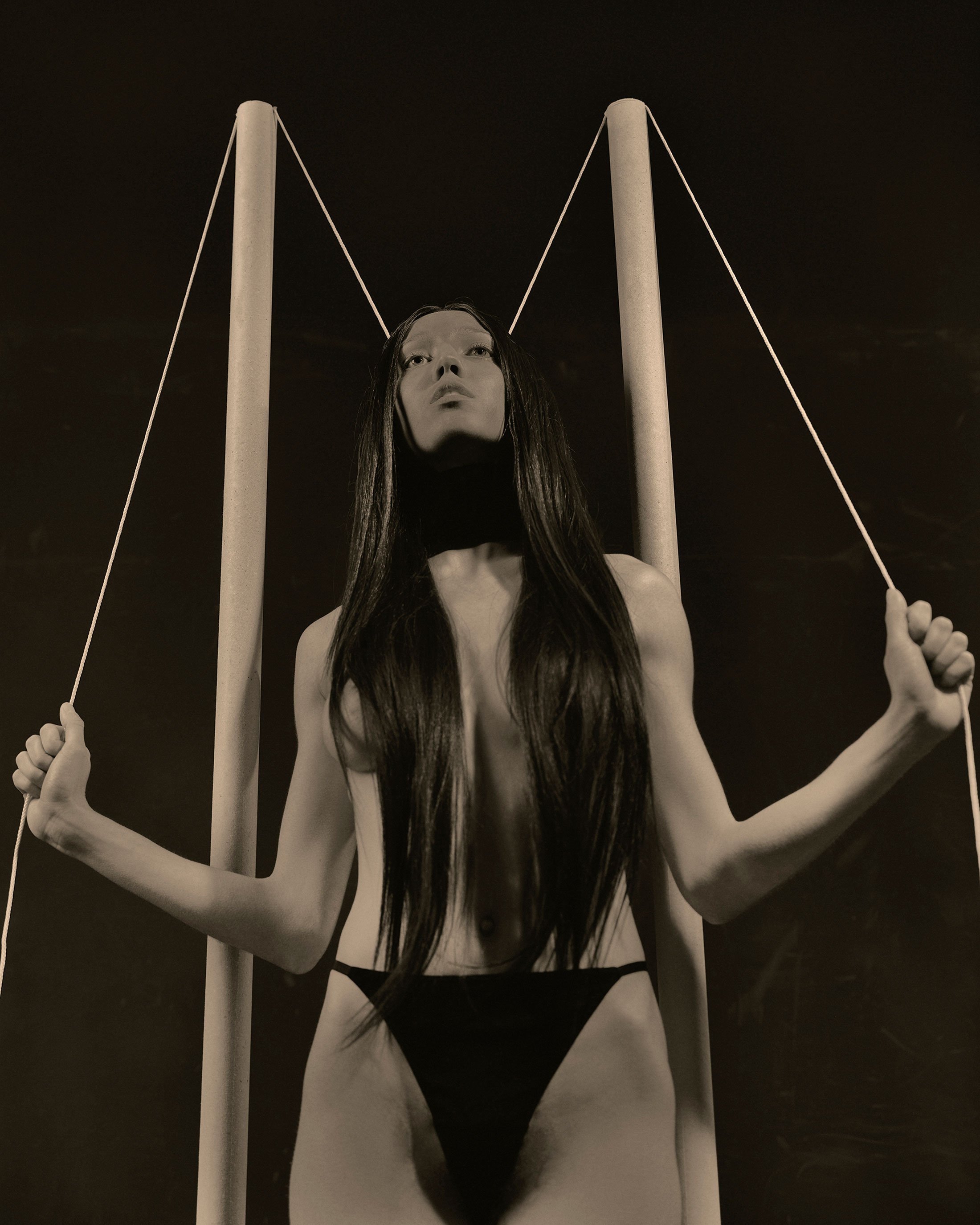Body Entity
Body Entity is a fashion story with roots in deep curiosity with Buddhist beliefs, which suggests that the skin of our body is not its limit. The body extends past its visible form with its experience of the surroundings. To depict this notion, the team decided to use two main techniques: dance and Trompe-l’oeil.
With the help of professional dancers, each body movement and posture became a frame caught in time with an evident expression that continues beyond. Trompe-l’oeil, an art technique that creates an optical illusion of 3D experience, was deployed through work with space and the black background. Styling comes as a strong nuance that emphasizes the visual idea of the story through the use of elastic clothes, adhesive tape, and airy fabrics.
We speak with Motoki Nakatani, a Photographer, on the main inspiration behind the shoot drawn from the surrealist Man Ray and interest in Buddhism. Motoki explains how this fascination led to the project, “I’ve decided to do simple visual experimentation on it within the frame of photography/fashion photography.” We discuss the characteristics of the body presented through motion and stillness and the similarities and differences between the human body posture and that of the marionette. The story brings a whole new angle to look at life and humans, to ask existential questions, and experience powerful emotions through the prism of an image.
Photography Motoki Nakatani Stylist Shinya Kuraoka Hairstylist Natsumi Ebiko Make-up Ruben Masoliver Models & Dancers Tehamour Thaïs Rambaut Iman Sahli Special thanks to Sheriff Projects
‘The first basic idea came from the fascination with surrealists like Man Ray, but mostly from the Buddhist belief that the skin is not a limit of ourselves.’
— Motoki Nakatani
Hi guys, let’s discuss the central theme of the editorial — the body and the physical boundaries of the body. How did the idea to research the continuity or discontinuity of the body and its extension to the world come about?
Motoki: So the first basic idea came from the fascination with surrealists like Man Ray, but mostly from the Buddhist belief that the skin is not a limit of ourselves. I’ve always been interested in such ideas as collective memory or spiritualism, so I’ve decided to do simple visual experimentation on it within the frame of photography/fashion photography.
‘We’ve discussed with the team how we could make certain parts of the body disappear and change the weights of a part of a body through techniques like Trompé-l’œil.’
— Motoki Nakatani
Work with materials that smoothly fit the curves of the skin, like leggings, fabric that hugs the body parts, and even adhesive tape come to emphasize, as you call it, the ‘physical limit’ of the body. What were some of the decisions you made choosing the suitable fabrics and styling the models on set?
Motoki: We’ve discussed with the team how we could make certain parts of the body disappear and change the weights of a part of a body through techniques like Trompé-l’œil. The adhesive tape was our stylist's Shinya idea who was inspired by a found image of the process of making a jacket/costume. Even though we consider tapes as something that puts together things, they could also serve for redrawing a body.
‘Dolls and puppets and even robots could imitate a strong movement of a human, but they also have this stiffness and awkwardness that interests me.’
— Motoki Nakatani
Adding dynamics of the moving body and working with dance movements provides a new angle of perception of the bodies: the strengths and fluidity in motion in contrast to the calm stillness. What was important in working with models/dancers on set, and the direction you gave them regarding the atmosphere and the moves?
Motoki: It’s interesting that you mentioned fluidity and stillness. Another visual aspect of this series is that sometimes the body becomes almost like a marionette (especially with make-up on a particular 'look'). Dolls and puppets and even robots could imitate a strong movement of a human, but they also have this stiffness and awkwardness that interests me, and I really wanted to try with those who excel in/study physical expression.
‘At the same time, monochrome images emphasize the volume and subtle differences of the skin.’
— Motoki Nakatani
Working with hairstyling and makeup is another element that adds to emphasizing the needed feeling of the moving models. How did you decide to help and express the characters through hair and makeup, especially dealing with black and white and sepia images?
Motoki: For hair and makeup, we had some ideas we already decided on before the shoot. But as you mentioned, it’s limited to work with it, especially in monochrome images. At the same time, monochrome images emphasize the volume and subtle differences of the skin, for example. They have done a great job, I think.
Which moment from this project is most precious to you?
Motoki: It’s something that always excites me to see the 'still' images in two-dimensional aspects. With 3D and continuous images that we live during the shoot, we are undoubtedly aware of the fake features of photography/fashion photography, but it’s magical enough what can be done in 2D.








